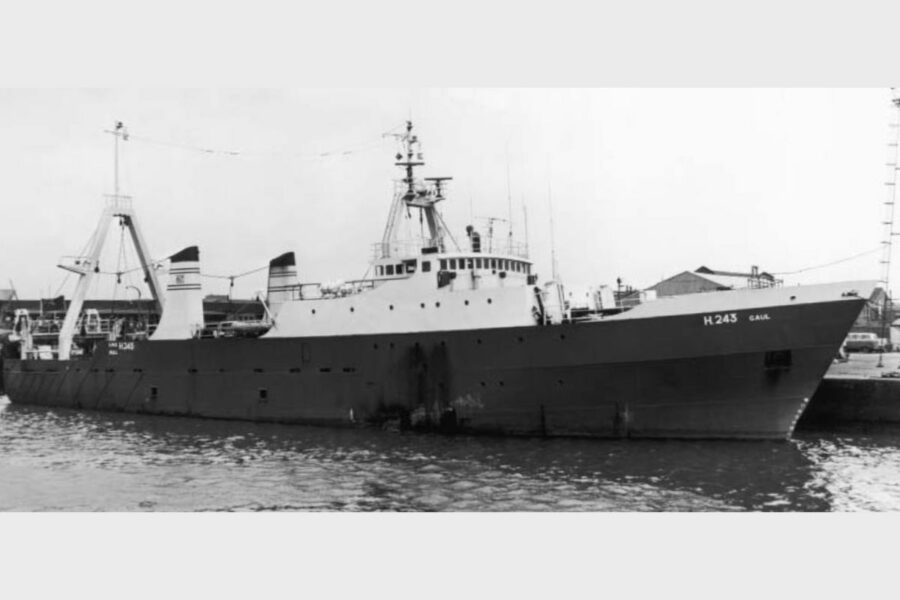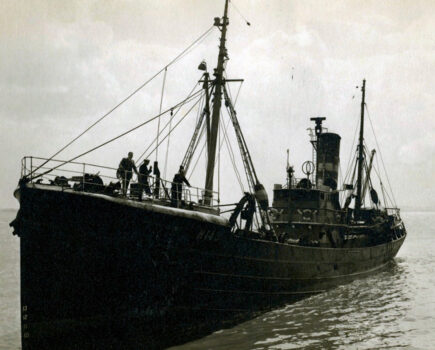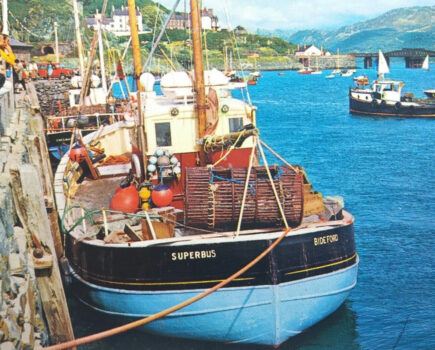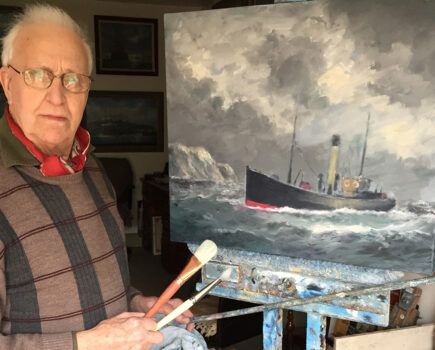Fifty-one years ago this February, the Hull trawler Gaul and her 36 crew were lost without trace, a tragedy that inspired decades of speculation and campaigning.
By BRIAN W LAVERY
In the years after the Gaul H 243 vanished off the North Cape of Norway, her name was rarely mentioned without ‘spyship’ preceding it. It was eventually accepted that the vessel had simply been overwhelmed by atrocious weather – but the years of campaigning in the wake of the tragedy would help to expose how the government had covered up the British fishing fleet’s involvement in Cold War espionage for decades.
The Gaul originally fished from North Shields as the Ranger Castor, and had been bought by British United Trawlers of Hull and renamed only the previous autumn. She was a super[1]modern, 1,100t freezer stern trawler.
Gaul left Hull on 22 January, 1974 for the North Cape commanded by relief skipper Peter Nellist in place of her usual skipper Ernie Suddaby.
On the way, Gaul stopped at Bridlington to pick up crewman Bill Treacy, and later signed up ‘stowaway’ John Heywood, who had fallen asleep after missing the ‘all passengers ashore’ announcement after he got drunk saying farewell to pals.
On 26 January, she called into Tromsø in Norway to land mate George Petty, who had suffered a rupture injury onboard. His replacement Maurice Spurgeon flew out next day.
The trawler arrived at North Cape Bank on 29 January with 36 men aboard. All were from Hull and North Shields, including the relief skipper and mate.
On 7 February, an autopilot system fault was reported. Next morning, Bill Brayshaw, mate of the Hull trawler Swanella, spoke with his friend Maurice Spurgeon by radio.
Blizzards made visibility almost impossible, and waves of up to 50ft battered vessels in force 10 gales. Swanella later reported a derrick ‘bent like a pin’ when a giant wave clattered it.
Other trawlers reported storm damage, and fought to avoid capsizing. The Gaul reported via radio that she was ‘laid and dodging near North Cape Bank’.
At 10.45am on Friday, 8 February, Bill Brayshaw turned the Swanella head to wind. He spotted the Gaul six miles astern on his radar. Two private telegrams were sent from the Gaul between 11.06am and 11.09am. These were the last communications from the vessel.
In Hull, staff failed to raise an alarm despite a weekend of radio silence. The subsequent inquiry heard that manager Tony Hudson had gone to a football game and failed to instruct the junior left in charge. He was later fired. This negligence would not have made a material difference, but would have started the search earlier, the inquiry court heard.
Once the Gaul was reported missing, a search involving the Royal Air Force, Royal Navy and Norwegian air and sea forces began – but they found no trace of the missing vessel.
A perfect storm for decades of conspiracy theories was created almost immediately. Some were credible, some crazy. They included the crew being captured by the Soviet Navy while spying, nets being dragged under by a submarine, and the vessel being sunk by the Russians after hitting an undersea ‘listening cable’.
For years, some relatives held on to the belief that their men were being held in a Soviet labour camp – or that both ship and crew were being held.
It had been known for trawlers to be tracked by the Russians, so this didn’t entirely lack credibility. In 1959, Hull trawler Arnold Bennett was held from 25 November to 15 December after an armed Soviet boarding party took her hostage. Back home, families were frantic.
Later, Skipper Eddie Gibbins told his local paper: “They had a complex about cameras. All they kept saying was ‘cameras, stowaways’. They were armed. They searched everywhere.”
Eddie Gibbins was later tried in Murmansk and fined for ‘illegal fishing’. The British Embassy paid the fine, and Arnold Bennett and her crew were home by New Year’s Day.
So not all suspicions were baseless, and there were real questions.
Why did the three-day, 177,000 square mile air-sea search find nothing, when it included aircraft that could spot a periscope from a mile above? Surely the Royal Navy search fleet, led by HMS Hermes and assisted by many UK trawlers, would have found something? And why, after a light was spotted by the Hermes, was nothing found when spotter planes went to its source?
There were at least 17 UK fishing vessels in the area at the time. There was also a NATO exercise underway, being observed by the Soviets, whose submarines were based nearby. Yet no one saw the Gaul go.
How could this modern vessel, with automatic Mayday distress signals, disappear without an SOS? Gaul also had life-saving gear for 50 as well as lifejackets, a lifeboat, six inflatable rafts and four lifebuoys – two of which were designed to float instantly if the vessel were to sink suddenly. And if a mine had been struck, there would have been an oil slick – yet no flotsam was found.
Many people refused to believe that the Gaul could have disappeared with neither trace nor communication. The gossip mill spun in Hull’s fishing community and beyond, aided and abetted by the media. The initial inquiry into the tragedy was only the beginning of a 30- year search for answers.
The 1974 inquiry at Hull City Hall, led by wreck commissioner Barry Sheen QC, had only been going 10 minutes when the spying claims began dramatically.
A woman shouted: “You know the Russians did it! Stop covering up!” Others joined in before all the relatives stormed out in protest. The next day’s papers were filled with ‘spyship’ headlines.
That inquiry eventually found that the Gaul foundered and capsized, probably while turning head to wind while a ‘succession of heavy seas’ hit her side on.
Claims that Gaul was a spyship, or that the British fishing fleet was involved in espionage, were dismissed by the court with what one newspaper described as a ‘judicial wave of the hand’.
A QC, summing up for the vessel owners, referred to the spy narrative as ‘Gaul nonsense’. Skipper Ernie Suddaby agreed, supported by George Petty, the mate who was flown home before the vessel’s disappearance. The court added that there was no evidence that would justify a further search.
But relatives clung to hopes that their men were in the Soviet Union, and demands for another search continued. Local MPs, led by John Prescott, lobbied defence secretary Will Rodgers for a response.
Will Rodgers’ answer was aimed at closing down conspiracy theories for good. He admitted that naval personnel had been ‘occasionally carried on trawlers to further seagoing and navigational experience’, but said: “Britain’s fishing fleet is not being, has not been, and will not be used for the gathering of intelligence.”
His statement was straight to the point. It was also untrue. But it would be another 20 years before the by then Lord Rodgers admitted to being ‘misled’.
Two determined Hull women, Beryl Betts and Betty Parker, who lost relatives on the Gaul, were the driving force behind a campaign to get to the truth about the vanished ship, forming the Gaul Families’ Association.
In May 1974, a Norwegian trawler found a life belt from the Gaul, and another unsuccessful call was made for a search to get to the truth. The two women wrote myriad letters, made countless TV and radio appearances, and lobbied MPs, trawler owners and anyone else who could keep the story alive.
A self-styled Irish marine investigator called Leo Sheridan raised money for an expedition that never came off. He was later discovered to have no maritime qualifications.
For decades Gaul lay undiscovered on the seabed – despite several trawlers reporting snagging their nets on wreckage in the area. There was an apparent reluctance by the British establishment to find her, the argument being that the waters were too deep and the cost would be prohibitive.
One story that would not go away was about Gaul’s radio operator John Doone. There was evidence that he was trained in intelligence gathering, according to his widow Sheila, who added that he ‘went missing for 10 days’ before Gaul sailed. An additional puzzling detail was that the father of three had signed on as having no next of kin.
In 1978, four years after the tragedy, one of John Doone’s closest friends, Allan Waterworth, allegedly spotted him in a bar in Durban, South Africa, and followed him to a Greek ship, which he boarded. Allan Waterworth went to his grave swearing he had seen John Doone that day.
Hull campaigner Betty Parker later got seeming confirmation of his claim from a Durban shipping agent, who said a man named John Doone was on a ship there that day, but had ‘since left their employ’.
In a Kafkaesque twist, widow Sheila Doone found herself unable to remarry years later because registrars in Lancashire said her husband’s fate could not be verified. She was told to ‘divorce’ him. The Daily Express featured the story on 6 August, 2002 with the headline ‘Why this widow needs to unlock the secrets of the Gaul’.
Allan Waterworth died in 1990 before he could testify to the second Gaul inquiry, but his family swore affidavits in support of his statement, as did the family friend who had brought the news of the sighting to Sheila Doone.
At the end of the 1990s, a new investigation into the tragedy by the Marine Accident Investigation Board was ordered by John Prescott, now Labour deputy prime minister.
This followed the 1997 Channel 4 Dispatches documentary Secrets of the Gaul, which not only located the trawler but sent a submersible to film her – something the government had repeatedly said would be ‘prohibitively expensive’.
With a budget of just £50,000, Scottish investigative journalists Norman Fenton and Callum Macrae put paid to the government claims, filming the vessel on the seabed using a hired submersible unit launched from a converted ferry they had rented.
They took with them Mason Redfearn and Walter ‘Gentleman Walt’ Lewis, two of Hull’s most respected skippers. There were also a couple of Gaul relatives aboard the ferry during the search.
Skipper Redfearn, now aged 88, told me: “It was so moving when the camera focused on the ship’s nameplate – it read Ranger Castor – the Gaul’s previous name. I remember thinking how bright it looked, as if it had been cleaned specially for us.”
Skippers Lewis and Redfearn both admitted on the documentary that they had been involved in espionage. What they didn’t know was that journalist Callum Macrae had a photo of a man the documentary team suspected was a spy recruiter.
“This was the big moment for the documentary,” Callum Macrae recalled. “If they didn’t identify the man in the photo, we would have looked rather stupid. Fortunately they both recognised him.”
The man was Commander John Brookes, a naval intelligence officer who for years hid in plain sight in a dockside office on Hull’s fish quay, recruiting trawlermen as intelligence gatherers for decades as part of what became revealed as ‘Operation Hornbeam’.
In his book MI6: Inside the covert world of Her Majesty’s Secret Intelligence Service, Stephen Dorril confirmed John Brookes’ involvement in Operation Hornbeam and cited Mason Redfearn’s spy work.
Stephen Dorril wrote: “Fishing fleets of Aberdeen and Hull were used to spy on the Soviet North Atlantic Fleet in Arctic waters. Operation Hornbeam was run by a senior NID [Naval Intelligence Department] officer Commander John G Brookes, from the basement of the dockside premises of a fishing company in Hull; during the mid-1960s he reported to the head of NID Rear Admiral Michael Kyrie-Pope, who has confirmed Hornbeam was the brainchild of MI6. Mason Redfearn was recruited in March 1963.”
Stephen Dorril went on to say that Mason Redfearn told him he had been trained how to use a spy camera, and that he would forward his findings to a Joint Intelligence Section within MI6.
Skipper Redfearn told FN: “There was no question of me or any of the others doing it for money. We did it for our country. My wife and I were once invited to London for the Trooping of the Colour by Brookie as a thank-you.”
Among his souvenirs, Mason Redfearn has a Christmas card signed by John Brookes and Michael Kyrie-Pope.
Skipper Redfearn and the other recruits were given Robot Star cameras, which took 48 frames a second, telescopes and books of silhouettes to help them identify Russian vessels. They were trained in London.
“We were told if ever a Soviet party boarded our ship, we were to put the equipment in a white canvas sack provided and throw it in the sea,” recalled Mason Redfearn.
“None of us spoke of what we did. We wanted to serve our country as best we could.” However, the fact that the ‘Navy men’ were regularly seen on trawlers was common knowledge among Hull’s fishermen.
The Dispatches documentary crew filmed a cable near the wreck which experts said was a SOSUS wire – used for tracing submarines. SOSUS is the acronym for the US sonar and surveillance system.
When the MAIB did its survey a year later, that cable was not there, and it was officially claimed that what the TV crew had seen must have been trawl wires. But Mason Redfearn said: “I know trawling wires when I see them, and that cable was nothing to do with fishing.”
Skipper Redfearn gathered affidavits from skippers nationwide admitting to spying for Britain, with a view to using them to campaign for compensation for former trawlermen.
He felt it unfair that patriots who had done so much for their country could be treated so badly. Trawlermen were classed as ‘casual workers’, so the trawler owners – which got millions for decommissioning vessels – were not compelled to compensate the men.
Dozens of skippers came forward, and Mason Redfearn kept all their testimonies.
The participation of Skippers Redfearn and Lewis in the Dispatches documentary raised that campaign’s profile, and exposed the lie that the fishing fleet was not involved in spying. A few years later, the campaign for compensation for former trawlermen was finally successful.
In 2004, a second Gaul inquiry was held. This reiterated that the vessel was overwhelmed by giant waves, and took water on from the stern.
The MAIB survey only resulted in the remains of four of the crew being identified – but by this time, the narrative of the Gaul being held by the Russians and the men being imprisoned had faded, and attitudes had changed with the evidence.
After decades of refusing to have his name on a memorial plaque, the family of 27-year-old Hull deckhand James O’Brien finally allowed him to join the commemorated.
In 1996, campaigner Beryl Betts had said she accepted that Gaul had probably been taken by huge seas, adding that she no longer thought there was ‘anything sinister’.
The final inquiry also reiterated that Gaul was never a spyship. But the vessel’s story and the focused campaigning that followed were instrumental in ending a 30-year government cover-up, and recognising the role of a group of patriotic British fishermen during the Cold War.
Thanks to retired marine architect Alan Hooper and former Hull Daily Mail editor Jamie Macaskill for providing some of the documents and images in this article.
This story was taken from Fishing News. For more like this, subscribe to Fishing News here or buy the latest single issue for just £3.50 here.
Sign up to Fishing News’ FREE e-newsletter here.








